从功能对等理论看商标词翻译中文化因素的处理
- 格式:pdf
- 大小:203.12 KB
- 文档页数:2
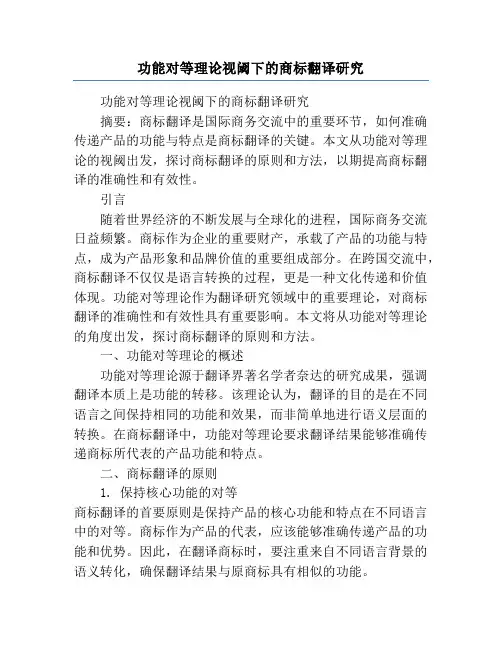
功能对等理论视阈下的商标翻译研究功能对等理论视阈下的商标翻译研究摘要:商标翻译是国际商务交流中的重要环节,如何准确传递产品的功能与特点是商标翻译的关键。
本文从功能对等理论的视阈出发,探讨商标翻译的原则和方法,以期提高商标翻译的准确性和有效性。
引言随着世界经济的不断发展与全球化的进程,国际商务交流日益频繁。
商标作为企业的重要财产,承载了产品的功能与特点,成为产品形象和品牌价值的重要组成部分。
在跨国交流中,商标翻译不仅仅是语言转换的过程,更是一种文化传递和价值体现。
功能对等理论作为翻译研究领域中的重要理论,对商标翻译的准确性和有效性具有重要影响。
本文将从功能对等理论的角度出发,探讨商标翻译的原则和方法。
一、功能对等理论的概述功能对等理论源于翻译界著名学者奈达的研究成果,强调翻译本质上是功能的转移。
该理论认为,翻译的目的是在不同语言之间保持相同的功能和效果,而非简单地进行语义层面的转换。
在商标翻译中,功能对等理论要求翻译结果能够准确传递商标所代表的产品功能和特点。
二、商标翻译的原则1. 保持核心功能的对等商标翻译的首要原则是保持产品的核心功能和特点在不同语言中的对等。
商标作为产品的代表,应该能够准确传递产品的功能和优势。
因此,在翻译商标时,要注重来自不同语言背景的语义转化,确保翻译结果与原商标具有相似的功能。
2. 适应目标语言文化背景商标翻译不能脱离目标语言的文化背景进行,要结合目标语言的习惯表达和文化特点进行翻译。
商标的语义和文化内涵往往与其所代表的产品和服务密切相关,因此商标翻译要注重文化适应性,以确保翻译结果在目标语言中能够与产品和服务产生良好的关联。
三、商标翻译的方法1. 直译法直译法是商标翻译中常用的一种方法,即将商标的词义逐字逐句翻译成目标语言。
这种方法在保留商标原貌和核心功能的同时,可能会忽视目标语言的文化差异。
因此,直译法在商标翻译中应谨慎使用,可以采用一定的调整和修饰,以适应目标语言和文化的特点。

学术研讨Academic research■ 邓娜从“功能对等”翻译理论看商标的翻译摘要:随着全球化的整体到来,国与国之前的商贸往来空前繁盛,各个国家的商品都走向国际,商标作为其商品的标志,企业的象征,企业的外包装,更是作为产品给人的第一印象出现在消费者的眼前,如何使它国的消费者接受并且成为开拓国际市场成功的第一步,所以其翻译变得尤为重要。
纵观国内外商标翻译的各种成功案例,“功能对等”翻译理论对其具有一定的指导意义。
本文将从功能对等的词汇对等、文化对等、目的对等这三项翻译原则来分析功能对等对商标翻译的指导作用。
关键词:“功能对等”;商标;翻译商标是商品或者企业将本身宣传给消费者一个重要的外包装。
这在商品销售过程中十分重要,一个释义贴近企业,能完美展示企业文化,特征及其精神的商标是尤为重要的。
而在跨文化,跨国交流传播时,企业或产品的商标如何在不损失原文含义,又能受众接受并熟记的商标翻译则更加重要。
为达到给予不同语言的消费者以源语言消费者一样的体验与感受,达到目的对等的要求,“功能对等”理论,又名“动态对等”理论,则能给予最全面、最科学的理论指导作用。
1商标翻译困难成因1.1文化差异在不同的国家,文化差异不仅存在历史层面,以及人们接受特定事物的观念,还表现在思维方式和沟通方法上。
Culture这个词来源于拉丁语,原意是“培养,栽培”的意思。
文化像个洋葱,有多层的皮,每个层面都包含一个关于你的标签,例如教育背景、肤色、生于何年代,学的是什么科学,兴趣是什么等,这些都组成了一个个体。
而一个包含这样的团体,与另外一个团体之间又有更多地差异。
文化也像一座冰山,水上的部分是可以观察到的部分,也是容易通过模仿而学习到的部分:饮食习惯,穿着,建筑,音乐,问候方式,语言等、但水下的部分是隐藏着的,却是巨大的:包括价值观,态度和信仰。
例如一个西方人到日本生活,学会日本人鞠躬很容易,但是要学会见不同的人鞠不同的度数的躬就很难。
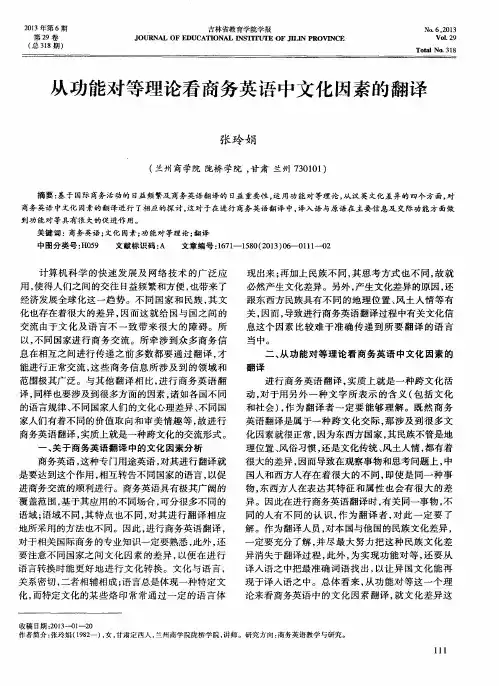
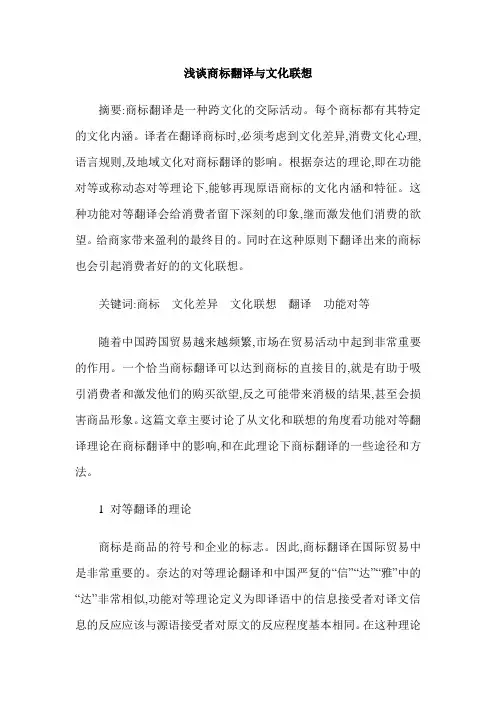
浅谈商标翻译与文化联想摘要:商标翻译是一种跨文化的交际活动。
每个商标都有其特定的文化内涵。
译者在翻译商标时,必须考虑到文化差异,消费文化心理,语言规则,及地域文化对商标翻译的影响。
根据奈达的理论,即在功能对等或称动态对等理论下,能够再现原语商标的文化内涵和特征。
这种功能对等翻译会给消费者留下深刻的印象,继而激发他们消费的欲望。
给商家带来盈利的最终目的。
同时在这种原则下翻译出来的商标也会引起消费者好的的文化联想。
关键词:商标文化差异文化联想翻译功能对等随着中国跨国贸易越来越频繁,市场在贸易活动中起到非常重要的作用。
一个恰当商标翻译可以达到商标的直接目的,就是有助于吸引消费者和激发他们的购买欲望,反之可能带来消极的结果,甚至会损害商品形象。
这篇文章主要讨论了从文化和联想的角度看功能对等翻译理论在商标翻译中的影响,和在此理论下商标翻译的一些途径和方法。
1 对等翻译的理论商标是商品的符号和企业的标志。
因此,商标翻译在国际贸易中是非常重要的。
奈达的对等理论翻译和中国严复的“信”“达”“雅”中的“达”非常相似,功能对等理论定义为即译语中的信息接受者对译文信息的反应应该与源语接受者对原文的反应程度基本相同。
在这种理论的指导下,商标翻译能够成功地吸引顾客和刺激他们的联想和购买欲望。
比如,“Carrefour”是一家非常大的连锁超市,在中国的翻译为“家乐福”。
这个翻译很符合中国人的口味。
因为“家乐福”给消费者一种高兴温暖的画面——合家欢乐,这有助于吸引消费者和激发他们的购买欲望。
2 商标翻译的方法2.1 音译音译法通常用于翻译人名或者公司的名称。
“Nokia”是世界上最著名的移动电话品牌之一。
这个名字来自于该手机公司所在的小镇。
中文的翻译“诺基亚”,使得人们似乎感受到该公司表达出来的意思―对亚洲的承诺。
著名的英国汽车品牌“Rolls-Royce”,中文的翻译为“劳斯莱斯”。
虽然此翻译并无任何特别的意思,可是我们仍能够感受到这个品牌的贵族血统。
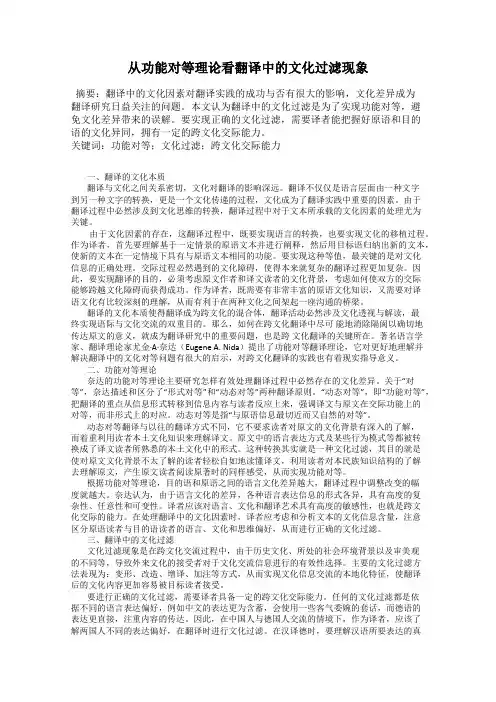
从功能对等理论看翻译中的文化过滤现象摘要:翻译中的文化因素对翻译实践的成功与否有很大的影响,文化差异成为翻译研究日益关注的问题。
本文认为翻译中的文化过滤是为了实现功能对等,避免文化差异带来的误解。
要实现正确的文化过滤,需要译者能把握好原语和目的语的文化异同,拥有一定的跨文化交际能力。
关键词:功能对等;文化过滤;跨文化交际能力一、翻译的文化本质翻译与文化之间关系密切,文化对翻译的影响深远。
翻译不仅仅是语言层面由一种文字到另一种文字的转换,更是一个文化传递的过程,文化成为了翻译实践中重要的因素。
由于翻译过程中必然涉及到文化思维的转换,翻译过程中对于文本所承载的文化因素的处理尤为关键。
由于文化因素的存在,这翻译过程中,既要实现语言的转换,也要实现文化的移植过程。
作为译者,首先要理解基于一定情景的原语文本并进行阐释,然后用目标语归纳出新的文本,使新的文本在一定情境下具有与原语文本相同的功能。
要实现这种等值,最关键的是对文化信息的正确处理。
交际过程必然遇到的文化障碍,使得本来就复杂的翻译过程更加复杂。
因此,要实现翻译的目的,必须考虑原文作者和译文读者的文化背景,考虑如何使双方的交际能够跨越文化障碍而获得成功。
作为译者,既需要有非常丰富的原语文化知识,又需要对译语文化有比较深刻的理解,从而有利于在两种文化之间架起一座沟通的桥梁。
翻译的文化本质使得翻译成为跨文化的混合体,翻译活动必然涉及文化透视与解读,最终实现语际与文化交流的双重目的。
那么,如何在跨文化翻译中尽可能地消除隔阂以确切地传达原文的意义,就成为翻译研究中的重要问题,也是跨文化翻译的关键所在。
著名语言学家、翻译理论家尤金·A·奈达(Eugene A. Nida)提出了功能对等翻译理论,它对更好地理解并解决翻译中的文化对等问题有很大的启示,对跨文化翻译的实践也有着现实指导意义。
二、功能对等理论奈达的功能对等理论主要研究怎样有效处理翻译过程中必然存在的文化差异。
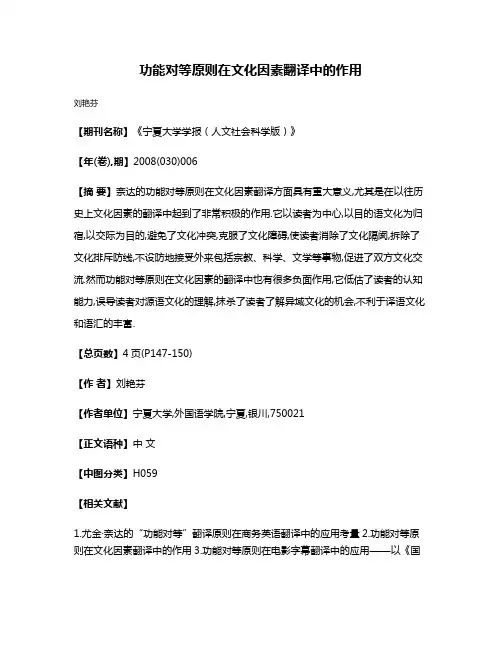
功能对等原则在文化因素翻译中的作用
刘艳芬
【期刊名称】《宁夏大学学报(人文社会科学版)》
【年(卷),期】2008(030)006
【摘要】奈达的功能对等原则在文化因素翻译方面具有重大意义,尤其是在以往历史上文化因素的翻译中起到了非常积极的作用.它以读者为中心,以目的语文化为归宿,以交际为目的,避免了文化冲突,克服了文化障碍,使读者消除了文化隔阂,拆除了文化排斥防线,不设防地接受外来包括宗教、科学、文学等事物,促进了双方文化交流.然而功能对等原则在文化因素的翻译中也有很多负面作用,它低估了读者的认知能力,误导读者对源语文化的理解,抹杀了读者了解异域文化的机会,不利于译语文化和语汇的丰富.
【总页数】4页(P147-150)
【作者】刘艳芬
【作者单位】宁夏大学,外国语学院,宁夏,银川,750021
【正文语种】中文
【中图分类】H059
【相关文献】
1.尤金·奈达的“功能对等”翻译原则在商务英语翻译中的应用考量
2.功能对等原则在文化因素翻译中的作用
3.功能对等原则在电影字幕翻译中的应用——以《国
王的演讲》的字幕翻译为例4.功能对等原则在文化因素翻译中的作用5.从功能对等理论浅析在商标翻译中对文化因素的处理
因版权原因,仅展示原文概要,查看原文内容请购买。
![毕业设计(论文)功能对等理论视角下的商标翻译研究[管理资料]](https://uimg.taocdn.com/e36932eaff00bed5b8f31da7.webp)
湖南文理学院芙蓉学院本科生毕业论文题目:A Study of Brand Name Translation from the Perspective of Functional Equivalence功能对等理论视角下的商标翻译研究学生姓名:罗菁学号:08050426专业班级:英语0804班指导教师:谭照亮完成时间:2012年5月A STUDY OF BRAND NAME TRNSLATION FROM THE PERSPECTIVE OF FUNCTIONAL EQUIV ALENCETHESISSubmitted in partial fulfillment of the requirements forThe degree of Bachelor of ArtsIn Forong college of Hunan University of Arts and ScienceBy Luo JingSupervisor: Tan ZhaoliangMay 2012Furong College of Hunan University of Arts and Science湖南文理学院芙蓉学院本科生毕业论文任务书湖南文理学院芙蓉学院本科生毕业论文成绩评定表(指导教师)备注:指导教师评语应从以下几方面评价。
1. 学习态度、纪律情况;2. 完成任务书规定工作情况(含对论文翻译的评价);3. 查阅和应用文献资料能力;4. 综合运用专业知识能力;5. 独立分析和解决问题的能力;;7. 创新与成效。
湖南文理学院芙蓉学院本科生毕业论文成绩评定表(评阅教师)备注:论文评阅人评语应从以下几方面评价。
1. 完成任务书规定工作情况;2. 毕业设计(论文)的难度与工作量;3. 综合运用专业知识能力;4. 内容的正确性和撰写规范化程度;5. 创新与成效。
湖南文理学院芙蓉学院本科生毕业论文成绩评定表(答辩委员会)备注:答辩委员会评语应从以下几方面评价。
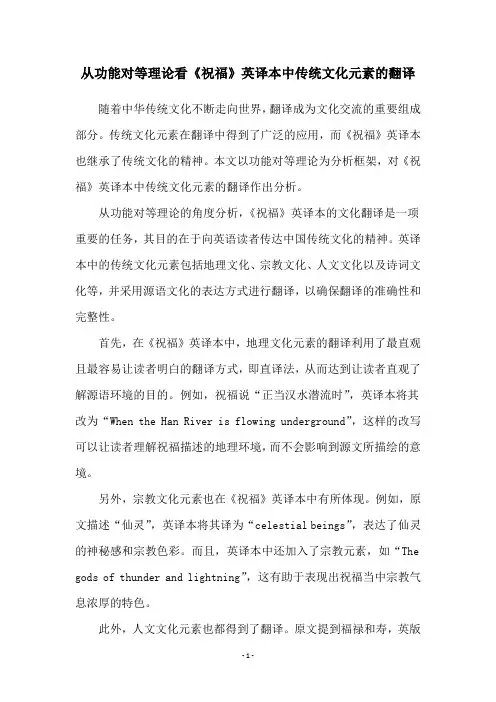
从功能对等理论看《祝福》英译本中传统文化元素的翻译随着中华传统文化不断走向世界,翻译成为文化交流的重要组成部分。
传统文化元素在翻译中得到了广泛的应用,而《祝福》英译本也继承了传统文化的精神。
本文以功能对等理论为分析框架,对《祝福》英译本中传统文化元素的翻译作出分析。
从功能对等理论的角度分析,《祝福》英译本的文化翻译是一项重要的任务,其目的在于向英语读者传达中国传统文化的精神。
英译本中的传统文化元素包括地理文化、宗教文化、人文文化以及诗词文化等,并采用源语文化的表达方式进行翻译,以确保翻译的准确性和完整性。
首先,在《祝福》英译本中,地理文化元素的翻译利用了最直观且最容易让读者明白的翻译方式,即直译法,从而达到让读者直观了解源语环境的目的。
例如,祝福说“正当汉水潜流时”,英译本将其改为“When the Han River is flowing underground”,这样的改写可以让读者理解祝福描述的地理环境,而不会影响到源文所描绘的意境。
另外,宗教文化元素也在《祝福》英译本中有所体现。
例如,原文描述“仙灵”,英译本将其译为“celestial beings”,表达了仙灵的神秘感和宗教色彩。
而且,英译本中还加入了宗教元素,如“The gods of thunder and lightning”,这有助于表现出祝福当中宗教气息浓厚的特色。
此外,人文文化元素也都得到了翻译。
原文提到福禄和寿,英版本将其翻译为“happiness,wealth and longevity”,这样的表达更能向读者传达出中国传统文化的精神,即尊重老人和乡村生活的价值观。
最后,诗词文化元素也得到了在英译本中的完整表达,如“荆棘红绪,银烛灿烂”,英译本表述为“piercing thorns, silver candlelight”,通过抒情的翻译表达,保留原文的美感,向读者传递传统文化的精神。
总之,《祝福》英译本中传统文化元素的翻译结合了源语文化的表达方式,以保证翻译准确性和完整性,让英文读者更有效地理解源语文化,进而更深刻地认识中国传统文化。
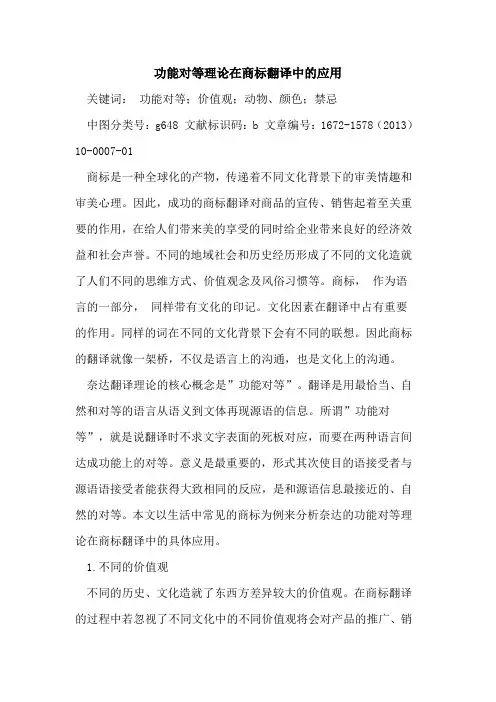
功能对等理论在商标翻译中的应用关键词:功能对等;价值观;动物、颜色;禁忌中图分类号:g648 文献标识码:b 文章编号:1672-1578(2013)10-0007-01商标是一种全球化的产物,传递着不同文化背景下的审美情趣和审美心理。
因此,成功的商标翻译对商品的宣传、销售起着至关重要的作用,在给人们带来美的享受的同时给企业带来良好的经济效益和社会声誉。
不同的地域社会和历史经历形成了不同的文化造就了人们不同的思维方式、价值观念及风俗习惯等。
商标,作为语言的一部分,同样带有文化的印记。
文化因素在翻译中占有重要的作用。
同样的词在不同的文化背景下会有不同的联想。
因此商标的翻译就像一架桥,不仅是语言上的沟通,也是文化上的沟通。
奈达翻译理论的核心概念是”功能对等”。
翻译是用最恰当、自然和对等的语言从语义到文体再现源语的信息。
所谓”功能对等”,就是说翻译时不求文字表面的死板对应,而要在两种语言间达成功能上的对等。
意义是最重要的,形式其次使目的语接受者与源语语接受者能获得大致相同的反应,是和源语信息最接近的、自然的对等。
本文以生活中常见的商标为例来分析奈达的功能对等理论在商标翻译中的具体应用。
1.不同的价值观不同的历史、文化造就了东西方差异较大的价值观。
在商标翻译的过程中若忽视了不同文化中的不同价值观将会对产品的推广、销售带来极大的影响。
例1.”kiss me”是一个日产唇膏的英文商标。
中译名为”奇士美”,没有按字面意思译为”吻我”。
在西方kiss me更能直接地表达女性的妩媚性感,符合西方人现代开放的审美观念。
但中国人在追求和表达爱时更加含蓄保守而且”奇士美”中的”奇士”和”骑士”同音和”美”连用很容易使人联想到帅气的英雄和靓丽的美女,因此比”吻我”更加符合中国人的审美观念。
例2.法国香水”poison”。
中文商标文为”百爱神”而不是“毒药“,更能给中国女性唯美的想象空间,而毒药则可能使中国女性对此产品产生误解敬而远之。
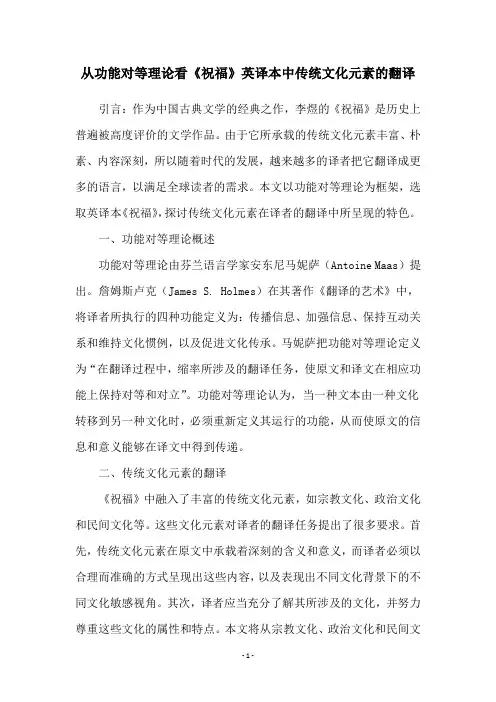
从功能对等理论看《祝福》英译本中传统文化元素的翻译引言:作为中国古典文学的经典之作,李煜的《祝福》是历史上普遍被高度评价的文学作品。
由于它所承载的传统文化元素丰富、朴素、内容深刻,所以随着时代的发展,越来越多的译者把它翻译成更多的语言,以满足全球读者的需求。
本文以功能对等理论为框架,选取英译本《祝福》,探讨传统文化元素在译者的翻译中所呈现的特色。
一、功能对等理论概述功能对等理论由芬兰语言学家安东尼马妮萨(Antoine Maas)提出。
詹姆斯卢克(James S. Holmes)在其著作《翻译的艺术》中,将译者所执行的四种功能定义为:传播信息、加强信息、保持互动关系和维持文化惯例,以及促进文化传承。
马妮萨把功能对等理论定义为“在翻译过程中,缩率所涉及的翻译任务,使原文和译文在相应功能上保持对等和对立”。
功能对等理论认为,当一种文本由一种文化转移到另一种文化时,必须重新定义其运行的功能,从而使原文的信息和意义能够在译文中得到传递。
二、传统文化元素的翻译《祝福》中融入了丰富的传统文化元素,如宗教文化、政治文化和民间文化等。
这些文化元素对译者的翻译任务提出了很多要求。
首先,传统文化元素在原文中承载着深刻的含义和意义,而译者必须以合理而准确的方式呈现出这些内容,以及表现出不同文化背景下的不同文化敏感视角。
其次,译者应当充分了解其所涉及的文化,并努力尊重这些文化的属性和特点。
本文将从宗教文化、政治文化和民间文化三个方面,讨论《祝福》英译本中传统文化元素的翻译特色。
1.教文化《祝福》中所涉及的宗教文化主要涉及传统的佛教和儒家思想。
如佛教中的“慈悲”概念,在英译本中则被以“Compassion”来表达,突出了作品中对仁者优思想的体现。
此外,“金钗”这一提及频繁的元素,也被英译成“golden pin”,更有力地突出了其古老和神圣的意涵。
2.治文化《祝福》中还有大量的政治文化元素。
这些政治文化的元素,一般都是用一些含义比较深刻的词语来表达,英译本也是如此。
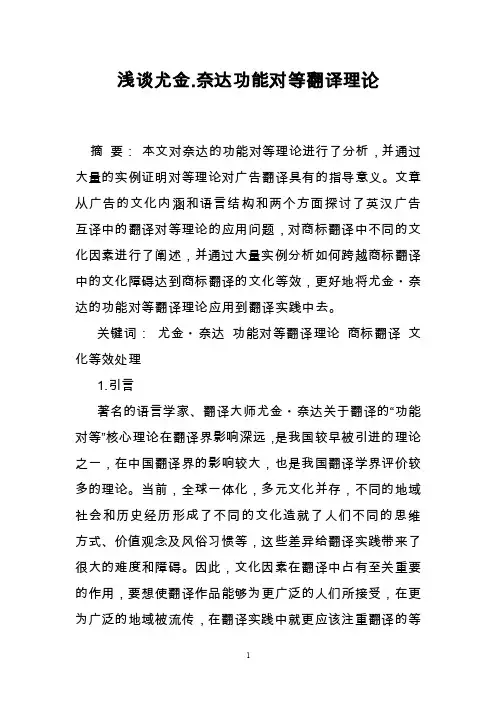
浅谈尤金.奈达功能对等翻译理论摘要:本文对奈达的功能对等理论进行了分析,并通过大量的实例证明对等理论对广告翻译具有的指导意义。
文章从广告的文化内涵和语言结构和两个方面探讨了英汉广告互译中的翻译对等理论的应用问题,对商标翻译中不同的文化因素进行了阐述,并通过大量实例分析如何跨越商标翻译中的文化障碍达到商标翻译的文化等效,更好地将尤金・奈达的功能对等翻译理论应用到翻译实践中去。
关键词:尤金・奈达功能对等翻译理论商标翻译文化等效处理1.引言著名的语言学家、翻译大师尤金・奈达关于翻译的“功能对等”核心理论在翻译界影响深远,是我国较早被引进的理论之一,在中国翻译界的影响较大,也是我国翻译学界评价较多的理论。
当前,全球一体化,多元文化并存,不同的地域社会和历史经历形成了不同的文化造就了人们不同的思维方式、价值观念及风俗习惯等,这些差异给翻译实践带来了很大的难度和障碍。
因此,文化因素在翻译中占有至关重要的作用,要想使翻译作品能够为更广泛的人们所接受,在更为广泛的地域被流传,在翻译实践中就更应该注重翻译的等效策略。
随着经济全球化的发展,世界各地的企业家都力求在全世界市场范围内树立自己的品牌形象,商标翻译质量直接影响商品在广大消费者中的认可程度,影响商品在市场上的竞争力,商标的翻译便成为企业进入世界市场的关键一步。
商标翻译是一种跨文化交际活动,涉及到地域文化、语言规律和审美取向等诸多因素。
企业要想使自己的产品成功地进入到某个国家的市场就必须注重产品商标的翻译质量。
本文通过对几个实例商标翻译的研究探析了文化等效翻译原则在翻译中的应用。
2.等效翻译理论尤金・奈达提出的“等效翻译理论”即在动态对等翻译中译语接受者和译语信息之间的关系应该与源语接受者和原文信息之间的关系基本相同的理论。
因此,在翻译中,根据奈达的理论,译者应以动态对等作为翻译的原则准确地在目的语中再现源语的文化内涵。
与以往的翻译理论相比较,功能对等理论的不同之处在于它将翻译纳入语言学的研究领域的同时,还将文化以及西方文论中的读者反应纳入到翻译研究的领域。
摘要商标名称是指商标中可以用语言称呼的部分,是产品的标记,是产品形象的重要内容之一。
本文从商标名称的相关知识入手,介绍了商标名称的概念、特征及功能。
商标名称是一种文化现象,我们在商标名称翻译时需要注意它的可行性,以奈达的”功能对等”理论作为商标名称翻译的基本原则及翻译的方法,这是一种可行的方法。
商标名称具有特有的文化特点,与文化有着密切联系,我们需要从不同国家的特性、习俗和习惯、语义联想等不同角度分析商标名称翻译过程中的文化障碍。
尽管在商标名称互译中存在文化障碍,但它们并不是不可以跨越的。
译者应灵活运用具体的翻译方法,跨越文化障碍,力求达到功能对等和最佳翻译效果。
关键词:功能对等;商标;翻译AbstractA brand name is the part of brand that can be vocalized, and the sign of a product. This paper starts with the information of brand names to introduce the definition, characteristics and the functions of brand names. The brand name is a phenomenon of culture. We should pay more attention to the possibil ity of brand name translation, and take the Nada’s “Functional Equivalence” as a cardinal principle and methods employed in brand name translation,this is a viable way. Brand names possess peculiar cultural characteristics and have intimate relation with culture,then we need analyze the cultural barriers of the brand name translation from different national traits, different customs and habits, different semantic associative. Although there are cultural barriers in the brand name translation, we can still overcome them. Translators should use the techniques flexibly so as to overcome the cultural barriers in brand name translation and try to translate brand names perfectly.Key words: functional equivalence; brand name; translationContents摘要 (i)A b s t r a c t...........................................................................i i I n t r o d u c t i o n (1)C hapt er 1 Overvi ew of Brand Nam es (2)1.1 Definition of Brand Names (2)1.2 Formation of Brand Names (2)1.2.1P r o p e r N a m e s (3)1.2.2C o m m o n Wo r d s (3)1.2.3C o i n e d Wo rd s (4)1.3 Characteristics of Brand Names (5)1.3.1B r e v i t y (5)1.3.2E l e g a n c e (6)1.3.3O r i g i n a l i t y (7)1.4 Functions of Brand Names (7)1.4.1In fo rm at i v e Fun c t i o n (8)1.4.2A e s t h e t i c F u n c t i o n (8)1.4.3E v o c a t i v e F u n c t i o n (10)Chapter 2 Functional Equivalence Theory and Brand NameTranslation (12)2.1 Funct i onal Equi val ence (12)2.2 Consideration of Factors in Brand Name Translation (13)2.2.1C o ns um e r P s yc h o l o g y (13)2.2.2 Cult ural Fact ors (14)2.2.3A e s t h e t i c Fa c t o r s (16)2.3 Application of Functional Equivalence in Brand Name Translation (16)2.3.1 Equivalence of Informative Function (16)2.3.2 Equivalence of Aesthetic Function (17)2.3.3 Equivalence of Evocative Function (18)Chapter 3 Methods Employed in Brand Name Translation (20)3.1 Li t er al Trans l a t i on (20)3.2Tr a n s l i t e r a t i o n (21)3.3 Combination of Literal Translation and Transliteration (23)3.4C r e a t i v e Tr a n s l a t i o n (24)3.4.1 Addition or Deletion (24)3.4.2B l e n d i n g (25)3.4.3A c r o n y m (26)3.4.4P u r p o s i v e M i s s p e l l i n g (26)C o n c l u s i o n (27)B i b l i o g r a p h y (28)AcknowledgementsIntroductionA brand name is a sign representing cultural characteristics of different nations, societies and times. It serves not only its expected functions of communication; it is also employed in a symbolic manner to identify a brand and its cultural origin. Today, well-known brand names have become cultural icons, and enjoy powerful advantages in the fierce competition. Brand names, as part of language, reflect the features of a certain nation, including the historical and cultural background, their attitudes towards life, and their life style and thinking pattern.Brand name translation is influenced by cultural elements which differentiate it from general translation. Brand name translation is of significance in the competitive market. Brand names mirror the culture of different countries, so cultural elements must not be ignored in the translating process. At present, with economic development and increasing international contact, the exchanges between different countries become more and more frequent. And trade surplus becomes an important part of our national economy. Proper translation of brand names also becomes more and more important so as to promote the sales of goods and cultivate foreign markets.Chapter 1Overview of Brand Names1.1 Definition of Brand NamesA brand name refers to a specific name employed by a corporation to identify uniquely a product or its manufacturer, or a service and its provider. (Li Guisheng,1996)It is quite often used interchangeably within “brand name”, although it is more correctly used to specifically denote written or spoken linguistic elements of any product. A legally protected brand name is called a proprietary name. A powerful brand name embodies a unique set of values and hence personality. A successfully designed brand name can bring about enormous value in a real sense, which is invisible wealth of a company. Therefore, brand name is of more and more importance in “global village” and the right and suitable meaning of a brand can be an enduring advantage.1.2 Formation of Brand NamesFrom the perspective of the linguistic structures, brand names can be mainly divided into proper name brand names, the common word brand names and the coined word brand names.(He Chuansheng,1997) However, there are some similarities and differences in the formation of Chinese and English cosmetic brand names.1.2.1 Proper NamesUsing a proper name especially a person’s name can create a sense of amicability between the product and the consumers. A good name will inspire the consumers to think about the image under that name. Take some brand names for example, “Charlie” in English has the long-standing image of being a confident but warm little girl; “大宝”in Chinese is an adorable nickname for a male who is the family members’ darling. When personal names are used as brand names, distance between the commodities and the consumers could be shortened while the sense of intimacy could be established. In such a delightful and cheerful state, consumers would be inspired to be better informed about the products, if interested and satisfied, they will purchase. Thus, a very successful sale could be fulfilled as the brand name fully performs its fundamental function.1.2.2 Common WordsCommon words will add more amicability and friendliness in the products and names provide the denominators and translators more choices. Usually, the common words used in Chinese and English brand names include adjective and noun.The brand names formed by common nouns have symbolic and metaphor functions. Products with these names possess the characteristics of these words or objects, for example, “Ivory” can make you skin smooth and white. The cosmetic brand names formed by adjectives or adjective plus noun can show a very direct description of the main characters of the product.1.2.3 Coined WordsWhen certain qualities, characteristics and functions are taken into consideration, coined words can be created. Since they are coined, they are unique and novel as there is not much possibility that another similar one will appear. Many English brand names are created by means of lexical methods, such as shortening, compounding, blending, affixation, etc while the Chinese brand names tend to use word group.Shortening is the simplified form of the original words. For example, “SR”, a brand name of toothpaste, is formed by acronym, that is, to use the initials of the ingredients of the product (Sodium, Ricinoleate).Compounding is a popular and crucial way of forming English and Chinese cosmetic brand names. By compounding, two or more words are together to show the feature, quality and function of the product, so compound brand names can illustrate the characteristics of the products from multi-perspectives. Examples are:“Body Flower” stresses its function of making the body full of the fragrance of flowers.“Head & Shoulders” stresses its function of moistening the hair and making it soft and easy to comb.Different from English, Chinese is the ideograph language. So word groups can be formed by putting characters together. Usually, certain words have good connotations are frequently used.Names of plants and animals are often used as brand names. Chinese cosmetic brand names have a preference of the pretty images of some of them which can arouse the interest and bring good association, such as“蜂花”(cosmetic),“紫罗兰” (cosmetic)and “佰草集” (cosmetic).The above-mentioned have attached great importance to the point that they are pure, natural and environmentally safe products by using the raw material from the outside world and the consumers can get the essence of the flowers and herbal extract by using them.1.3 Characteristics of Brand NamesA brand name is the name of a product, which is a mark or a symbol that can be used to define a certain product. The goal of a brand name should aim at setting up a good image in the market, arousing consumers’ favorable association and purchasing desire. Thus the language used in brand names must have some features of its own.1.3.1 BrevityBrevity is a basic requirement of a good brand name, which means brand names should concise in spellings and pronunciations to make them eye-catching and easy to remember. According to an investigation, Chinese brand names consist of mainly two or three characters, and 70% of them (including Chinese versions of foreign ones) are two-character construction, 29% are three-character construction, only about 1% are more than five characters. Name a few as examples, “立白”(washing powder), “碧浪” (washing powder), “汰渍” (washing powder), “雕牌” (washing powder), “奥妙” (washing powder), “海尔”(electric appliance), “双星”(sports product).Whereas most English brand names are made up of one to four syllables on most occasions. Brand names such as “Benz” and “Ford”(cars) consist of one syll able; Brand names like “Sony”(electric appliance) and “Kodak”(film) are composed of two syllables; those like “Accustom”(watch) and “Adidas”(clothing) are made up of three syllables; “Electrolux”(appliance) comprises four syllables. In addition, most of these syllables consist of sonorous vowels and consonants with less friction, making the brand name easy to pronounce and remember.1.3.2 EleganceAs far as elegance is concerned, it means that both brand names and their rendered versions should have favorable association but avoid unpleasant connotation that may offend customers to arouse consumers’ purchasing desire. For example, the Chinese version “金利来” for the English brand name “Goldlion” is better than “金狮”, for “金利来” not only presents consumers the good quality of the tie but indicates the profit or good luck it can bring. While on the other hand, brand names such as “交际花”, “舞女” are forbidden to register in our country according to our Interim Regulations of Brand Name Registration because of their vulgar tastes.1.3.3 OriginalityA brand name should be as novel and unconventional as possible in wording, pronunciation, meaning and other aspects, so as to arouse the interest of the consumers and leave a deep impression on them.There are a variety of methods that can be used to achieve this effect. Word formation such as abbreviation, initials, numbers, and parallelism is one way to create originality. The brand name “TCL”(TV set) is special and new in home-made TV sets. Appealing sound is another way to obtain this effect. “Yahoo” and its Chinese version “雅虎” have a very peculiar and strong phonological effect and thus cause a pleasant psycho-acoustic impact on its hearers. Still unusually combination of common words, or coined words in Engl ish brand names, such as “7-up”(beverage), “0M0” (powder) and so on, leave a fresh yet deep impression on costumers because of their unique form and pronunciation.1.4 Functions of Brand NamesThe brand name is intended to appeal to the target consumers favorable meaning so as to spread ideas or information about persuade symbolic, or convince consumers. The basic functions of brand with pleasant sound and the products that will names are informative, evocative and aesthetic.1.4.1 Informative FunctionIt is well known that high-information is an important value of advertisement, to say nothing of its core, brand name. Brand name should firstly be informative to provide the consumers with information about the uses, characters, values and the target consumers.For example, brand names such as “Benz” (car), “Mary Kay” (cosmetics), “蒙牛”(milk),“张小泉”(scissors),“青岛”(beer) provide consumers with product makers, materials and producing areas. Those like “Microsoft” (computer), “H20” (cosmetics), “立白” (washing p owder), “舒肤佳”(soap) provide us with the information about basic uses of products. Brand names such as “钻石”(watch) imply the characteristics and the value of the products. Brand names can also indicate who the potential consumers are, such as “兰贵人”(cosmetic s), “劲霸”(apparel), “淑女屋”(apparel), etc.1.4.2 Aesthetic FunctionIn order to appeal to consumers, a good brand name should also have an aesthetic effect on them. Information alone supplied by brand names is far from enough to attract consumers and they should also bring consumers pleasant feelings, which can be manifested in the following three aspects — sound, form and meaning.To begin with, sound is not only an indispensable element of a brand name, but also an essential way to attract consumers, i.e. a means of accomplishing advertising effect. So on TV advertisements, brand names are always articulated. Brand names with beautiful sound are preferred by consumers as well as brand name designers. For example, “Kodak” (camera) simulates the sound when we push the shutter of a camera, while “Pepsi” reminds us of the sudden sound “si-” when we open up a bottle of soda drink and “Coca-Cola” is rhythmic and harmonious, easily pronounced and remembered.Then, form is closely related with psychology, and could arouse consumers’ psychological and visual reaction. A brand name with aesthetic features in form is more outstanding. For instance, “S” reminds people of lady’s curvilinear figure. That’s why many femalearticles are named with “S” added, such as, “Aeress” (underwear), “Finess” (cosmetics), “Simples” (cosmetics), etc.Last but not least, semantic aesthetics should also be taken into consideration. Favorite Chinese characters in brand names include “诚”(honesty), “梦”(dream), “爱”(love), “美”(beauty)etc. It is the same case with “淑女屋”(apparel), which attracts girls who desire to be gentlewomen.1.4.3 Evocative FunctionA brand name has evocative function, which means the brand names must interest consumers and stimulate them to make a purchase. According to Newmark, a typical example of evocative texts is advertisement. As the essential part of the advertisement, the brand name has the evocative as its basic function, which is based on its informative and aesthetic functions.In order to realize its evocative function, many brand names tend to choose words with favorable meanings. They offer consumers a kind of aesthetic feeling and arouse their purchasing desire. It turns out that brand names with exotic flavor can arouse peop le’s interest and persuade them to give it a try. For instance, the “Safeguard” (soap) implies that the soap can protect your skin and you more beautiful. And the Chinese brand name “皇冠”(automobile), which means crown, hints the quality of being superior and noble. Such kind of brand names will certainly appeal to consumers and result in their purchasing.Brand names can also succeed in persuading people by catering to their psychological needs. Brand names with romantic connotation can always attract the young customers and stir their enthusiasm of making a purchase. That’s why most costume brand names are common words full of imaginary or romantic connotation so as to meet the purchasing psychology of those young ladies and thus catch their attention. “Kis s-Me” (lipstick) is a call of love and “Youngor” (clothing) tells you that you will be younger than before if you are wearing this kind of clothes. “旺旺”(food) exactly expresses people’s best wishes of being healthy, wealthy and outstanding.B.A Thesis Chapter 2 Functional Equivalence Theory and Brand Name TranslationChapter 2Functional Equivalence Theory and Brand NameTranslation2.1 Functional EquivalenceTranslation equivalence is one of the central topics of translation research. Realizing that no translation is able to attain complete equivalence to the original, Nida advocates the idea of “functional equivalence”. According to Eugene A. Nida, a minimal, realistic definition of functional equivalence could be stated as “the reade rs of a translated text should be able to comprehend it to the point that they can conceive of how the original readers of the text must have understood and appreciate it” (1993:118).In addition, a maximal, ideal definition could be stated as “the readers of a translated text should be able to understand and appreciate it in essentially the same manner as the original readers did” (1993:118). However, this maximal level of equivalence is rarely achieved in practice. In fact the idea “equivalence” is appro ached on the basis of degrees of closeness from minimal to maximal effectiveness.To put it more specific, a minimal adequacy of translation is that the target readers can conceive of how the source readers must have understood and appreciated the source text; a maximal adequacy of translation might be that the target readers can understand and appreciate the translated text in essentially the same manner as the source readers understand and appreciate the source text. Nida suggests that when literal translation fails to attain satisfactory equivalence, adjustments in form are necessary (1993:125).Furthermore, in order to produce functionally equivalent translation, he proposes “the great the differences in the source and target cultures, the greater the need for adjustments; the greater the differences between the source and target languages, the greater the need for adjustments” (1993:129).2.2 Consideration of Factors in Brand Name Translation2.2.1 Consumer PsychologyConsumer psychology in a narrow sense refers to the mental state of a consumer and in a broad sense; it means the science of consumer psychology. It can be defined as “the mental or psychological activities of consumers in their realization, adjustment, and control of purchasing and consuming actions according to their own needs and abilities under the influence of the general social environment of consumption andeconomy”.(Gu Wenjun, 2002: 7)The majority of consumers are the intended reactors of marketing activities. Brand name translation, an indispensable procurer of such activities, is consumer-oriented. Consumers in the target market play the roles as the reader, the addressee, and eventually the reactor of a translated brand name. And the translator of a brand name can be regarded as a target-market brand name producer expressing a source-market brand name producer’s intentions.Information about the target-text addressee is of crucial importance for the translator of the brand name, and the goal of sales promotion is to stimulate immediate consumer purchasing. Therefore, the translator should enable a brand name to attract the attention, to arouse the curiosity and interest of the consumers, to satisfy their psychological needs and further stimulate their motives to purchase the particular commodity.2.2.2 Cultural FactorsCulture has its certain underlying characteristics which can be associated with brand names. Culture exists to satisfy the needs of the people within a society. It offers order, direction and guidance in all phases of human problem solving by providing “tried-and-true” methods of satisfying physiological, personal, and social needs.(Jiang Lei,2003)For example, culture provides standards and “rules” about when to eat, where to eat, and what is appropriate to eat for breakfast, lunch, dinner, and snacks, and what to present your parent and the aged. Soft-drink companies would suggest that the consumers should choose their products containing more vitamins and minerals since health is the first priority in modern society. In china, we used to have porridge or soy bean milk for breakfast. So, the manufacturer would produce the household mixer w hose slogan might be “soy bean milk is your best choice”.Besides company image strategies, many well-known brands spotlight their cultural connotation. They emphasize what they sell is not a product, but a certain culture, a national spirit. In this regar d, “Haier” means aiming higher and being sincere. So, cultural meaning can move from the culturally constituted world to consumer goods and from there to the individual consumer by means of various consumption-related vehicles, including brand names of course.Since culture is considered as the totality of beliefs and practices of a society, nothing is more important and effective than language through which the beliefs are expressed and transmitted and by which the cultures are conveyed and transferred. It is believed that where there is language, there is culture hidden behind. Language is a kind of institutional culture in some sense. It is not grasped by individuals but shared by a certain society. It is influenced by certain culture and in turn mirrors the culture. Brand names, as part of language, are of no exception. They areinfluenced by culture and in turn reflect culture. Therefore, culture has its underlying characteristics which can be associated with brand names.2.2.3 Aesthetic FactorsAs has been discussed in the first chapter, brand names possess the aesthetic function. In the process of translation, it is vital to reproduce the original aesthetic features of the brand names to the addressees. Brand name translation is demanded to be practical and aesthetic and translators will not only have to reserve the essence of the original brand name but also conform to the aesthetic psychology of consumers. Xu Yuanchong (2006:73) argues that translation is an art to transfer one language into another. His theory regarding to aesthetics in poetry translation goes like this: “beauty in sound, beauty in form and beauty in image”. Consequently, aesthetic factors should be taken into great account in the translation of brand names.2.3 Application of Functional Equivalence in Brand NameTranslationAs Nida’s functional equivalence the equivalent function indicates, an effective translation version should be able to produce or in other words the most proximal function to both the target and the original receptors. A translator must be clear about the functions of the source language, which is the prerequisite for a translator to achieve functional equivalence. Thus, brand name translation should take the functions of original brand name into full consideration in order to achieve functional equivalence.2.3.1 Equivalence of Informative FunctionFirst of all, brand name translation is usually informative. Equivalence in informative function is required. This requires that the renderings must be able to inform people of the functions, characteristics and values of the products as the original brand names do. To achieve the informative requirement, brand name should contain as much information as possible, readable to give the receptors strong impression. Some kinds of brand names inform the consumers of the basic functions of certain products. An English brand name “Goodyear” (tyre), which consists of “good” and “year” (two common words), meaning that if you use this tyre you will be smooth and happy through the whole year because the tyre lasts long in use. And the Chinese translation “固特异” is as good as the original one. “固” implies “lasting long” and “特异”means “extraordinary”. So we can see from the translated name that the life of this tyre will last extraordinarily long. It suggests the function of the tyre.2.3.2 Equivalence of Aesthetic FunctionThe aesthetic function refers to that brand names can provide theaudience with aesthetic feeling. No matter how faithful it is to its original in meaning, any slight failure to aesthetic function may render the name to the state of being rejected by consumers. The renderings should create a sense of beauty either in form or in context to the same or similar extent to the original ones so as to achieve equivalence in aesthetic function. It is of no doubt that a brand name must not only provide information about the product, but also please people and help them to bring aesthetic feeling. Most brand names are carefully selected to perform their aesthetic function, which is mainly realized by creating phonetic beauty, semantic beauty and imaginary beauty. “Coca-Cola” (beverage) is a distinguished example. It is translated to “可口可乐” in Chinese. The version not only imitates alliteration like the original one, but also helps to arouse favorable associations of customers and also consider the phonetic beauty.2.3.3 Equivalence of Vocative FunctionS imply speaking, the vocative function means that brand name can arouse people’s interest and persuade them to make purchases.Brand name translation should not only inform people of the value of products, but also cater to the customers’ psychological need to achieve equivalence in vocative function. One example is “Mr. Muscle” (a detergent brand name). If it is translated as “肌肉先生”,Chinese people are likely to associate it with a person who merely has a simple brain and strong limbs without intelligence. Of course, such a translated version in Chinese will attract few people’s interest and its vocative function would be impossib le. A revised version of “威猛先生” can fulfill its vocative function of inducing housewives to do some cleaning with this detergent.Besides the above-mentioned equivalence in functions of brand names, a translator must also take into consideration simultaneously such elements as linguistic and cultural factors in order to achieve functional equivalence in brand name translation.Chapter 3Methods Employed in Brand Name Translation As discussed above, the successful observance of the principle of “functional equivalence” in translating source brand names into target ones depends on many factors, among which the most important is the flexible employment of translation techniques in practice. There are four kinds of translation techniques: literal translation, transliteration, combination of literal translation and transliteration and creative translation.3.1 Literal TranslationLiteral translation means translating meanings literally, namely, keeping both the original form and the original sense. It is often used when the brand names can find corresponding expressions in target language. As Chinese and English cultures share many similarities, many brand names can be translated into target language by literal translation, especially those brand names invented after the names of plants, animals, birds or precious things like gem, diamond and gold. (Murphy, 1987)For example, “梅花”(recorder) is translated as “Plum Blossom”; “小天鹅”(washing-machine) as “Little Swan”; “钻石”(watch) as “Diamond”; “金杯”(sports shoes) as “Golden Cup”. Some Brand names which indicate the material, the quality, the usage and the peculiarity of certain products can be translated into English by this technique as well.Literal translation is often adopted in many cases as an effective technique for achieving functional equivalence in translating brand names. Nevertheless, translators must make sure first that versions produced by this technique are acceptable in other culture and are not negative in the target market. And this is of great importance, for we may fail to reproduce the same vocative function of the brand names if we do something opposite. For example, “白翎”(White Fe ather) are well accepted in domestic market; while in American and British market, the product was rejected, because its English rendering White Feather does not meet the psychology of the potential customers. In their culture, to show the white feather is a means of insulting, equivalent to abuse the person for being coward.3.2 TransliterationTransliteration refers to the way of translating brand names by taking the sounds of words instead of their verbal meanings into account. It is frequently used when the brand names created by culture-specific。
功能对等论和关联翻译论指导下的商标翻译作者:李成明谭雪蓉来源:《考试周刊》2013年第37期摘要:改革开放以来,尤其是在当下全球化时代,世界各国的贸易往来愈发频繁,越来越多的国外商品涌入中国市场,与此同时越来越多的国内商家把眼光投向国际市场。
在这样激烈的国际竞争中,商品商标品牌的翻译就显得十分重要。
本文以功能对等论和关联翻译论为指导依据,分析如何有效地进行商标翻译。
关键词:商标翻译功能对等论关联翻译论在商品经济迅速发展的今天,一个好的商标会帮助企业树立良好的形象,赢得消费者的青睐,并激起他们的购买欲望,从而迅速进入消费市场,在激烈的国际竞争中站稳脚跟。
然而商标翻译并不是简单的语言转化,而是两种文化之间的交流。
因此,商标翻译在传神地表达产品的特点和性能的同时译出其文化内涵,对企业的国际形象和产品在国际市场的地位至关重要。
本文从功能对等论和关联翻译论探讨在新的市场消费环境下如何有效进行商标翻译。
一、功能对等论指导下的商标翻译翻译是通过语言媒介将一种语言转换成另外一种语言。
由于受到两种不同民族文化和历史背景等诸多因素的影响,转换过程中的“源语”和“目标语”的意义并不完全对等。
当代翻译理论的奠基人、美国翻译理论大家尤金·奈达提出“动态对应”(功能对等)的概念,并将其定义为:目标语读者应该以源语读者理解原文的方式来理解译文[1]。
该定义旨在强调功能对等是译文和原文在语言功能上的对等而非语言形式上的对等。
奈达重视译文在源语和目标语读者心中的反应是否相似而非只关注语言形式的对应。
功能对等理论重点是目标语读者对于译文的反应,因此,根据奈达的功能对等理论,在进行商标翻译的过程中要充分考虑目标市场消费群体对于译名的心理反应度和情感接受度。
这就要求译者在商标翻译过程中不仅考虑目标语言文字的表达形式,更重要的是考虑目标消费群体的生活环境和社会文化背景。
文化与语言的关系密不可分[2]。
翻译是一种跨文化交际的行为,两种语言的交流在一定程度上也是两种文化的交流。